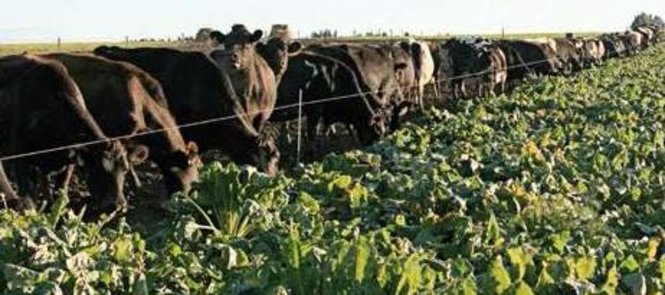Transitioning stock onto fodder beet
- Significantly changing the diet of animals usually has some health risks as stock adjust to the new feed. This is particularly so for fodder beet due to the risk of rumen acidosis.
- To transition stock well onto fodder beet can take up to 3 weeks and requires careful management.
- This information is only a guide. Seek further advice if new to grazing fodder beet.
Rumen acidosis
Rumen acidosis is caused by animals eating diets high in water soluble carbohydrates (WSC) or starch too quickly.
It is much less likely to occur where animals have had access to silage/hay/straw prior to being offered the crop (i.e. they are not hungry) or are well adjusted to the daily allocation of crop. Acidosis is most likely in hungry animals, during the transition period, or where crop allowance is suddenly increased (e.g. cows break out, or break size is mistakenly increased).
With acidosis, rapid fermentation of the WSC causes the pH of the rumen to drop rapidly, often below pH 5.5. The change in acidity alters the rumen flora, with acid- producing bacteria taking over, exacerbating the problem. The low rumen pH can result in rumen stasis (no rumen contractions), reduced fibre digestion and depressed appetite, all of which affect production. In severe cases acidosis can lead to death.
Visual symptoms of acute rumen acidosis in cattle are:
- Scouring
- Reduced appetite
- Loss of body condition
- Bloating
- Dehydration
- Laminitis
- Rumenitis
- Milk fever
Clinical rumen acidosis is usually only the tip of the iceberg, and with every clinical case there are likely to be sub-clinical cases which go unnoticed. The way to reduce this risk is good transition of animals onto fodder beet, and avoiding any sudden increases in daily intake.
Planning ahead
How the crop is to be fed should determine the planting layout. Provide good access for stock and allow enough room for the entire mob to get on the crop, but without over- allocating the amount of feed. This can be a challenge in very high yielding crops in the early stages of transition.
One way to achieve this is to plant a greenfeed crop in a headland (e.g. 6 m wide) parallel to the rows of fodder beet. The greenfeed can then be used during transition as an alternative feed source, which is not high in readily fermentable carbohydrate. Alternatively fodder beet in the headland can be lifted mechanically or manually, and fed to the animals at a low level to start the transition phase. Both of these options can ensure that you have enough space for stock in the fodder beet paddock to help manage the transition phase.
Planting layout should also consider how to best feed the crop. Usually you want to graze parallel to the rows to make allocation of feed easier. Long narrow breaks, where animals are eating under the wire, are best as this helps ensure that animals have equal access to the crop and none are pushed to the back. It also improves crop utilisation, with less treading of the crop.
Fodder beet in the diet
The daily allocation of fodder beet to animals will depend on the stock class, age, desired liveweight gain and the amount of crop available. After transitioning stock onto fodder beet it is recommended to continue feeding ≥30% of the animals’ diet as high quality supplement to minimise potential animal health issues. However, it is
acknowledged that experienced farmers are successfully operating systems at higher feeding levels.
Where high levels of fodder beet are fed over a 24 hour grazing period, the risk of animal health effects (rumen acidosis) are reduced, as stock intake rates are much slower than when feeding over a 4-5 hour period.
High utilisation rates (e.g. 90%) can be achieved on fodder beet, even with high crop allocation levels, as the feed quality of the whole plant is high. This is different to kale, for example, where lower utilisation rates are required for high animal performance as the feed quality declines down the plant stem.
Low levels of fodder beet in the diet are sometimes targeted due to performance levels required (e.g. maintenance feeding), or when fodder beet does not meet the nutritional needs of the stock. This is the case for lactating dairy cows, where it is suggested that no more than 5 kg DM/cow/day is fed, due to low protein levels in fodder beet.


